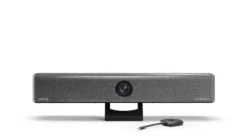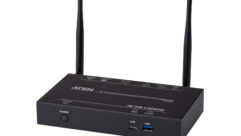

It’s a Wireless World
THERE’S A TERM THAT MAY BE FOREIGN to AV, but it’s well known in both in telecom and IT engineering: wire speed. It describes the maximum data rate that a particular cable technology can support. But it’s also shorthand for ?very, very fast,? setting a high bar for wireless technologies to clear before wireless can gain market acceptance.
THERE’S A TERM THAT MAY BE FOREIGN to AV, but it’s well known in both in telecom and IT engineering: wire speed. It describes the maximum data rate that a particular cable technology can support. But it’s also shorthand for “very, very fast,” setting a high bar for wireless technologies to clear before wireless can gain market acceptance.
Nevertheless, another crop of new wireless technologies is aiming at some of pro AV’s most bandwidth-intensive applications, including HD video. In fact, many of the newcomers have made HD part of their brand in an apparent attempt to show that they have what it takes to handle one of AV’s most demanding applications.
Wireless High-Definition Interface (WHDI) is one of two new wireless technologies targeting high-definition video applications in the consumer and pro markets. WHDI’s developer — Herzlia, Israel–based Amimon — says products should debut in early 2008. Sanyo demoed WHDI products at this year’s CES and InfoComm shows.
One new player is WirelessHD, which promises to deliver up to 4 Gbps over a distance of 10 meters within a room. (Data rates are lower if walls and other obstructions are in the way, as is the case with rival technologies.) That’s fast enough to handle 1080p video with no compression required.
“Practically all of the hundreds of millions of wired connections between video sources and displays today are based on delivery of uncompressed video,” says John Marshall, president and chairman of the WirelessHD Special Interest Group (SIG).“In order to truly replace these wired links, the wireless interface needs to be uncompressed, as well.”
It also needs to be fast — really fast.
“To do real HD, 1080p, you need 4.6 Gbps,” says Les Chard, president of HDMI Licensing, based in Sunnyvale, Calif. “Wire will always be faster than wireless. Wireless is okay for some applications, but for the main HD solution, I’m still kind of skeptical. If you’ve got a corporate projector that you want to put up on the ceiling in a conference room, and you don’t necessarily need HD, wireless is a great solution for that.”
SMART ANTENNAS
WirelessHD is among the newcomers using “smart antenna” technology, an increasingly common feature in wireless, including cellular telephony. Smart antenna techniques vary, but the common denominator is that they manipulate signals in order to increase data rates and work around interference. That ability is particularly valuable for WirelessHD because of its high frequency: 60 GHz. By comparison, the 802.11a version of Wi-Fi is in the 5 GHz band.
“The problem is that when you go that high in frequency, interference becomes a big issue,” says Brian O’Rourke, principal analyst at Scottsdale, Ariz.–based In-Stat. “The possibility of the slightest things interfering are greatly enhanced.”
Some of those things can move, creating a radio frequency (RF) environment where there are multiple, constantly changing variables, all potentially affecting throughput and in turn the technology’s ability to provide a good AV experience.
For example, a person walking between a projector and video source. “[WirelessHD’s antenna technology] looks for problems, and when the beam starts to break, it directs the antenna another way,” O’Rourke says.
SETTING PRIORITIES
Another new technology that uses smart antennas is Wireless High-Definition Interface (WHDI), developed by Amimon, a semiconductor manufacturer based in Herzlia, Israel. WHDI operates at a relatively low 5 GHz, where the company says its technology can deliver up to 3 Gbps in a 40 MHz-wide block of spectrum or 1.5 Gbps using a 20 MHz swath.
Smart antennas are particularly useful at 5 GHz because in North America the band is unlicensed —essentially a free-for-all among WHDI, Wi-Fi, and any other technologies that set up shop there. No licenses also means no legal recourse against interferers, leaving smart antennas as one way to ensure that video quality isn’t compromised.
On the plus side, signals travel farther at lower frequencies and are better able to plow through walls.Those abilities could be a plus in the eyes of integrators and their clients because it provides more design flexibility.
“The range is beyond 100 feet,” says Noam Geri, Amimon’s co-founder and vice president of business development and marketing. “It crosses several walls.”
Besides robustness, WHDI also is looking to differentiate itself in terms of video quality. The company uses what it calls a “video modem” approach, which identifies pixels that if lost or corrupted on the air link would be most noticeable. The bits that make up those crucial pixels get special handling.
“Because of the way that we prioritize the video, the errors occur on the less important information,” Geri says. “The [traditional] ‘data modem’ approach tries to protect all of the bits the same way.”
It’s a Wireless World
THERE’S A TERM THAT MAY BE FOREIGN to AV, but it’s well known in both in telecom and IT engineering: wire speed. It describes the maximum data rate that a particular cable technology can support. But it’s also shorthand for ?very, very fast,? setting a high bar for wireless technologies to clear before wireless can gain market acceptance.
WHERE’S THE MARKET?
WHDI and WirelessHD have another thing in common: Both are aimed primarily at the consumer market, although their backers see opportunities in the pro space, too. “WirelessHD has the flexibility to work well in HDTVs, adapter products, as well as enterprise AV applications, like high-end cameras and business projectors,” Marshall says. WirelessHD technology is designed for use [by] consumer electronics manufacturers, PC manufacturers, network infrastructure providers, and others to incorporate into their product lines for wireless communications.”
WHDI’s and WirelessHD’s ability to grab market share depends partly on their ability to compete on price with other wired and wireless technologies. That ability hinges on a variety of factors, one of which is spectrum.
For example, WirelessHD’s choice of 60 GHz is a mixed blessing. The band is practically virgin territory, which means there are no other commercial technologies to compete with it there. But no other technologies also means no off-the-shelf RF components to leverage in order to reduce the cost of WirelessHD.
“There are no commercial technologies at that frequency, so my big concerns are can they commercialize it, and can they do it at a price that will entice consumer electronics makers?” says O’Rourke.
Another issue is ease of connection. With cables, it’s easy to establish a connection. But with wireless, one device has to literally find the other. That hunt is a major reasons why Wi-Fi projectors and displays have languished as niche plays in the pro market. With few exceptions, there’s no easy way for a presenter to walk into a conference room, open her laptop, have it find the wireless projector, and establish a connection.
WirelessHD addresses that issue with a concept that its backers call an intelligent Wireless Video Area Network (WVAN).
“The coordinator, often the HDTV in the home, sends a signal to identify the other WirelessHD-based devices in the room,” Marshall says. “Once they are identified, the devices send information about their capabilities back to the coordinator or TV. With this information, users can manage the WVAN network with a remote control using the TV as the interface.”
Vendor interest and support is another concern. WirelessHD’s founders include some industry heavyweights: LG, Matsushita, NEC, Samsung, Sony, and Toshiba. By comparison, WHDI is backed mainly by Amimon thus far, although it has managed to attract interest from at least one major AV vendor. Amimon also wants to create a consortium to make WHDI an industry standard, and it’s interested in fostering an ecosystem of devices that bridge WHDI and legacy connectivity standards.
“There’s also a lot of interest in the pro AV market,” Geri says. “[At InfoComm 2007 and CES 2007,] Sanyo showed a wireless projector using WHDI technology primarily for professional and commercial uses.”
Amimon is selling WHDI chipsets now, and the company expects AV products that use the technology to debut in first quarter 2008. If that outlook becomes reality, WHDI would have a head start over WirelessHD, whose SIG was founded only in October 2006.
“Our current estimate is that WirelessHD-based products could begin shipping as early as Q4 2008, with volume ramping up in 2009,” Marshall says.
WIRELESS HDMI: THE PHANTOM TECHNOLOGY
The arrival of two wireless technologies with HD in their brands begs a question: What about Wireless HDMI? The answer: Even though Googling the term brings up dozens of products and references, there is no such technology.
“That’s actually a misuse of our trademark,” Chard says. “They usually call it ‘Wireless for HDMI’ because there’s no one standard. HDMI didn’t bless one single wireless solution.”
Instead, HDMI Licensing focuses on a wireless technology’s support of the HDMI spec, such as in terms of content protection. But what happens on the air link between two compliant devices is out of HDMI Licensing’s control. “I can’t be the compression police,” Chard says.
Tim Kridel is a freelance writer and analyst covering telecom and technology based in Columbia, Mo. He can be reached at [email protected].










